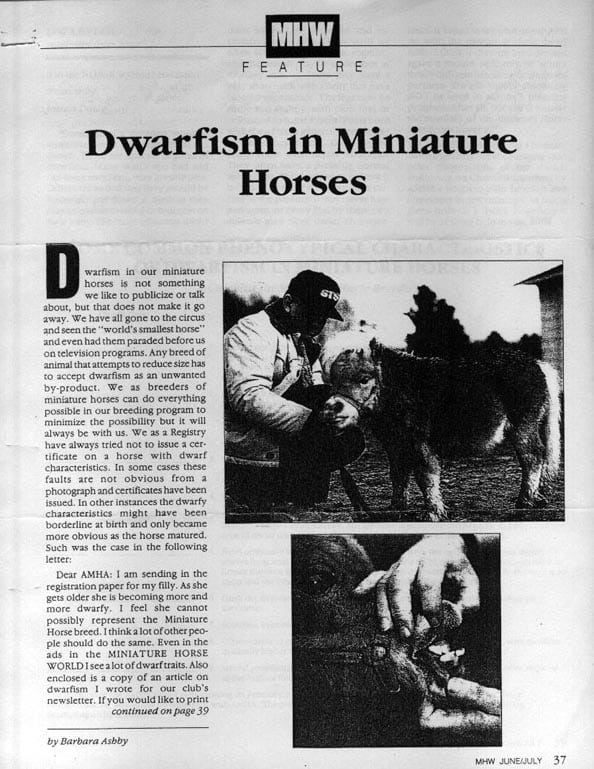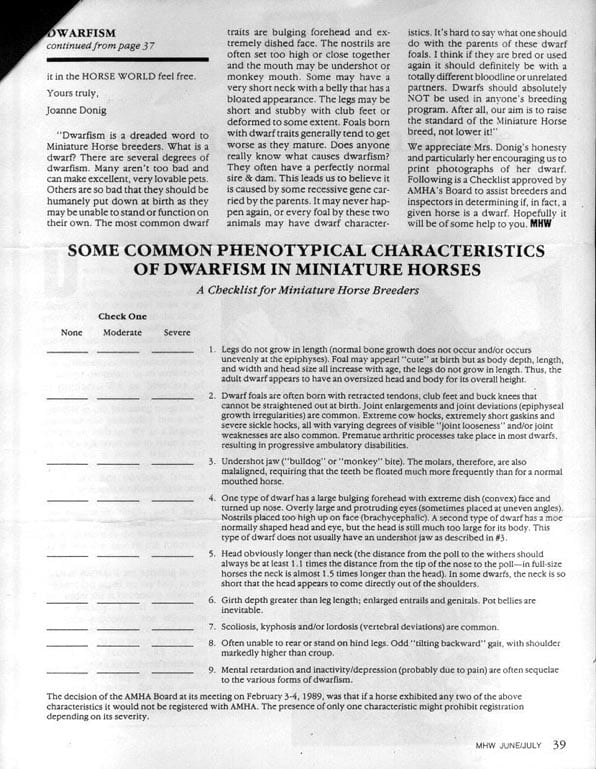The following is an article written by Barbara Ashby which appeared in the MINIATURE HORSE WORLD some time ago:
Dwarfism in our miniature horses is not something we like to publicize or talk about, but that does not make it go away. We have all gone to the circus and seen the “world’s smallest horse” and even had them paraded before us on television programs. Any breed of animal that attempts to reduce size has to accept dwarfism as an unwanted by-product. We as breeders of miniature horses can do everything possible in our breeding program to minimize the possibility but it will always be with us. We as a registry have always tried not to issue a certificate on a horse with dwarf characteristics. In some cases these faults are not obvious from a photograph and certificates have been issued. In other instances the dwarfy characteristics might have been borderline at birth and only became more obvious as the horse matured. Such was the case in the following letter:
Dear AMHA: I am sending in the registration paper for my filly. As she gets older she is becoming more and more dwarfy. I feel she cannot possibly represent the Miniature Horse breed. I think a lot of other people should do the same. Even in the ads in the MINIATURE HORSE WORLD I see a lot of dwarf traits. Also enclosed is a copy of an article on dwarfism I wrote for our club’s newsletter. If you would like to print it in the HORSE WORLD feel free. Yours truly, Joanne Donig
“Dwarfism is a dreaded word to Miniature Horse breeders. What is a dwarf? There are several degrees of dwarfism. Many aren’t too bad and can make excellent, very lovable pets. Others are so bad that they should be humanely put down at birth as they may be unable to stand or function on their own. The most common dwarf traits are bulging forehead and extremely dished face. The nostrils are often set too high or close together and the mouth may be undershot or monkey mouth. Some may have a very short neck with a belly that has a bloated appearance. The legs may be short and stubby with club feet or deformed to some extent. Foals born with dwarf traits generally tend to get worse as they mature. Does anyone really know what causes dwarfism? They often have a perfectly normal sire and dam. This leads us to believe it is caused by some recessive gene carried by the parents. It may never happen again, or every foal by these two animals may have dwarf characteristics. It’s hard to say what one should do with the parents of these dwarf foals. I think if they are bred or used again it would definitely be with a totally different bloodline or unrelated partners. Dwarfs should absolutely NOT be used in anyone’s breeding program. After all, our aim is to raise the standard of the Miniature Horse breed, not lower it!”
We appreciate Mrs. Donig’s honesty and particularly her encouraging us to print photographs of her dwarf. Following is a Checklist approved by AMHA’s Board to assist breeders and inspectors in determining if, in fact, a given horse is a dwarf. Hopefully, it will be of some help to you.
Some Common Phenotypical Characteristics of Dwarfism in Miniature Horses
A Checklist for Miniature Horse Breeders
- Legs do not grow in length (normal bone growth does not occur and/or occurs unevenly at the epiphyses). Foal may appear “cute” at birth but as body depth, length, and width and head size all increase with age, the legs do not grow in length. Thus, the adult dwarf appears to have an oversized head and body for its overall height.
- Dwarf foals are often born with retracted tendons, club feet and buck knees that cannot be straightened out at birth. Joint enlargements and joint deviations (epiphyseal growth irregularities) are common. Extreme cow hocks, extremely short gaskins and severe sickle hocks, all with varying degrees of visible “joint looseness” and/or joint weakness are also very common. Premature arthritic processes take place in most dwarfs, resulting in progressive ambulatory disabilities.
- Undershot jaw (“bulldog” or “monkey” bite). The molars, therefore, are also malaligned, requiring that the teeth be floated much more frequently than for a normal mouthed horse.
- One type of dwarf has a large bulging forehead with extreme dish (convex) face and turned up nose. Overly large and protruding eyes (sometimes placed at uneven angles). Nostrils placed too high up on face (brachycephalic). A second type of dwarf has a more normally shaped head and eye, but the head is still much too large for its body. This type of dwarf does not usually have an undershot jaw as described in #3).
- Head obviously longer than neck (the distance from the poll to the withers should always be at least 1.1 times the distance from the tip of the nose to the poll–in full-size horses the neck is almost 1.5 times longer than the head). In some dwarfs, the neck is so short that the head appears to come directly out of the shoulders.
- Girth depth deeper than leg length; enlarged entrails and genitals. Potbellies are inevitable.
- Scoliosis, kyphosis and/or lordosis (vertebral deviations) are common.
- Often unable to rear or stand on hind legs. Odd “tilting backward” gait, with shoulder markedly higher than croup.
- Mental retardation and inactivity/depression (probably due to pain) are often sequelae to the various forms of dwarfism.
The decision of the AMHA Board at its meeting on February 3-4, 1989, was that if a horse exhibited any two of the above characteristics it would not be registered with AMHA. The presence of only one characteristic might prohibit registration depending on its severity.


